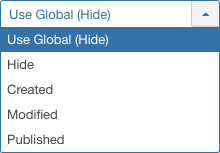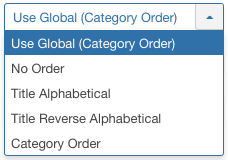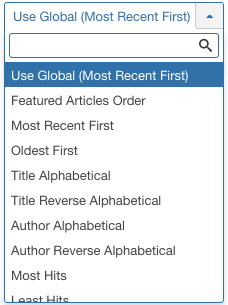Difference between revisions of "Menu Item: Category List"
From Joomla! Documentation
m |
m |
||
| Line 17: | Line 17: | ||
** Then select the '''New''' button in the Toolbar.</translate> | ** Then select the '''New''' button in the Toolbar.</translate> | ||
<translate><!--T:6--> | <translate><!--T:6--> | ||
| − | ** Then select the Menu Item Type Select button</translate> [[File:Help-4x-Menu-Item-Type-Select-Button-<translate><!--T:142--> | + | ** Then select the Menu Item Type Select button</translate> [[File:Help-4x-Menu-Item-Type-Select-Button-<translate><!--T:142--> en</translate>.png]] |
| − | en</translate>.png]] | ||
<translate><!--T:131--> | <translate><!--T:131--> | ||
** Then in the modal dialog popup, select the Articles tab link and then select Category List from the list of link types.</translate> | ** Then in the modal dialog popup, select the Articles tab link and then select Category List from the list of link types.</translate> | ||
Revision as of 08:44, 29 June 2022
Description[edit]
The Category List menu item type is used to show articles belonging to a specific Category in a list layout.
How To Access[edit]
To create a new Category List menu item:
- Select Menus → [name of the menu] from the Administrator menu (for example, Menus → Main Menu).
To edit an existing Category List menu item:
- Select its Title in the Menus: Items list.
Screenshot[edit]
Form Fields[edit]
- Menu Title: The title that will display for this menu item.
- Menu Item Type. The Menu Item Type selected when this menu item was created. This can be one of the core menu item types or a menu item type provided by an installed extension.
Details Tab[edit]
Left Panel
- Menu Item Type. The Menu Item Type selected when this menu item was created. This can be one of the core menu item types or a menu item type provided by an installed extension.
- Choose a Category. The Categories that are within this category will be displayed.
Right Panel
- Menu. Shows which menu the link will appear in.
Category Tab[edit]
The Category Options control the way that category information is shown in the layout. The Category List Layout has the following Category Options, as shown below.
- Category Title. (Use Global/Hide/Show) If Show, the Category Title will show as a subheading on the page. The subheading is usually displayed inside the "H2" tag.
- Category Description. (Use Global/Hide/Show) Show or hide the description of the selected Category.
- Category Image. (Use Global/Hide/Show) Whether to hide or show the category image.
- Subcategory Levels. (Use Global/All/1-5) The number of levels of subcategories to show in the layout. Select All to show all levels in the subcategory hierarchy.
- Empty Categories. (Use Global/Hide/Show) Whether to hide or show the categories that contain no content items or subcategories.
- No Articles Message: (Use Global/Hide/Show) If set to Show, the message 'There are no articles in this category' will display when a category contains no articles.
- Show Subcategories Text: (Use Global/Hide/Show) If show, the "Subcategories" will show as a subheading on the page. The subheading is usually dispayed inside the "H3" tag.
- Subcategories Descriptions. (Use Global/Hide/Show) Whether to hide or show the category description of subcategories.
- # Articles in Category: (Use Global/Hide/Show) Whether to hide or show the count of articles in each category.
- Show Tags: (Use Global/Hide/Show) Show the tags for the category.
- Page Subheading: Optional text to show as a page subheading.
List Layouts Tab[edit]
List Layout Options control the appearance of the list layout.
- Display Select. (Use Global/Hide/Show) Whether to hide or show the Display # control that allows the user to select the number of items to show in the list. An example of how it is shown in the Front End (website) view below.

- If there are more items than this number, you can use the page navigation buttons (Start, Prev, Next, End, and page numbers) to navigate between pages. Note that if you have a large number of items, it may be helpful to use the Filter options, located above the column headings, to limit which items display.
- Filter Field. The Filter Field creates a text field where a user can enter a field to be used to filter the articles shown in the list. An example of how this looks in the front-end layout is shown below.

- The possible options for this (in the back-end menu item edit) are shown below.

- Use Global: Use the value from Articles: Options. Only appears in Menu Item Type Options.
- Hide: Don't show a filter field.
- Title: Filter on article title.
- Author: Filter on the author's name.
- Hits: Filter on the number of article hits.
- Table Headings. (Use Global/Hide/Show) Table Headings show a heading above a list, like generic heading image shown below.

- If set to Show, this heading will show above the list. If set to Hide, the list will show with no headings.
- Show Date. This option allows you to show a date in the list. The options are as follows.

- Use Global: Use the value set in Article Manager→Options.
- Hide: Don't show any date.
- Created: Show the created date.
- Modified: Show the date of the last modification.
- Created: Show the start publishing date.
- Date Format. Optional format string to control the format of the date (if shown). If left blank, the date will use the DATE_FORMAT_LC1 format from the language file (for example, "D M Y" for "31 December 2012" or "m-d-y" for "12-31-12"). See PHP Date Documentation for more information.
- Show Hits in List. (Use Global/Hide/Show) Whether to hide or show the number of hits for this item.
- Show Author in List. (Use Global/Hide/Show) Whether to hide or show the name of the author.
- Show Votes in List. (Use Global/Hide/Show) Whether to hide or show the articles votes in the list of articles. This item is only displayed if the Vote plugin is enabled.
- Show Ratings in List. (Use Global/Hide/Show) Whether to hide or show the articles ratings in the list of articles. This item is only displayed if the Vote plugin is enabled.
- Category Order. Order of Categories in this Layout. The following options are available.
-
- Use Global: Use the default value from the component options screen.
- No Order: Articles are ordered only by the Article Order, without regard to Category.
- Title Alphabetical: Categories are displayed in alphabetical order (A to Z)
- Title Reverse Alphabetical: Categories are displayed in reverse alphabetical order (Z to A)
- Category Manager Order: Categories are ordered according to the Order column entered in the Articles: Categories page.
- Article Order. Order of articles in this Layout. The following options are available.
-
- Use Global: Use the default value from the component options screen.
- Featured Articles Order: Articles are ordered according to the Order column entered in Articles: Featured.
- Most recent first: Articles are displayed starting with the most recent and ending with the oldest.
- Oldest first: Articles are displayed starting with the oldest and ending with the most recent.
- Title Alphabetical: Articles are displayed by Title in alphabetical order (A to Z)
- Title Reverse Alphabetical: Articles are displayed by Title in reverse alphabetical order (Z to A)
- Author Alphabetical: Articles are displayed by Author in alphabetical order (A to Z)
- Author Reverse Alphabetical: Articles are displayed by Author in reverse alphabetical order (Z to A)
- Most Hits: Articles are displayed by the number of hits, starting with the one with the most hits and ending with the one with the least hits
- Least Hits: Articles are displayed by the number of hits, starting with the one with the least hits and ending with the one with the most hits
- Article Manager Order: Articles are ordered according to the Order column entered in the Articles.
- Date for Ordering. The date used when articles are sorted by date. The following options are available.
- Created: Use the article created date.
- Modified: Use the article modified date.
- Published: Use the article start publishing date.
- Pagination. Hide or Show Pagination support. Pagination provides page links at the bottom of the page that allow the User to navigate to additional pages. These are needed if the listed items will not fit on one page. An example is shown below.
-
- Use Global: Use the default value from the component options screen.
- Auto: Pagination links shown if needed.
- Show: Pagination links shown if needed.
- Hide: Pagination links not shown. Note: In this case, Users will not be able to navigate to additional pages.
- Pagination Results. Hide or Show the current page number and total pages (e.g., "Page 1 of 2") at the bottom of each page. Use Global will use the default value from the component options.
- # Articles to List: The number of articles to include in the list. Select the desired number from the list box.
- Featured Articles: (Use Global/Hide/Show) Select to show, hide or only display featured articles.
Options Tab[edit]
The Category List Layout has the following Article Options, as shown below. These options determine how the articles will show in the list layout.
In addition to Yes/No or Hide/Show, these options allow the following settings.
- Use Global: Use the default value from Articles: Options.
The Article Options are as follows.
- Title. Whether or not to show the Article's Title.
- Linked Titles. If the Article's Title is shown, whether to show it as a link to the article.
- Intro Text. If set to Show, the Intro Text of the article will show when you drill down to the article. If set to Hide, only the part of the article after the "Read More" break will show.
- Category. Whether or not to show the Article's Category.
- Link Category. If the Article's Category is shown, whether to show it as a link to a Category layout (list or blog) for that Category.
- Parent Category. Whether or not to show the Article's Parent Category.
- Link Parent Category. If the Article's Parent Category is shown, whether to show it as a link to a Category layout (list or blog) for that Category.
- Associations. Multilingual only. If set to Show, the associated articles flags or URL Language Code will be displayed.
- Author. Whether to show the author of the Article.
- Link to Author's Contact Page. If the Article's author is shown, whether to show it as a link to a Contact layout for that author. Note that the author must be set up as a Contact in Contact: Edit.
- Create Date. Whether or not to show the Article's create date.
- Modify Date. Whether or not to show the Article's modify date.
- Publish Date. Whether or not to show the Article's start publishing date.
- Navigation. Whether or not to show a navigation link (for example, Next or Previous article) when you drill down to the article.
- Show Voting. (Use Global/Hide/Show). Whether or not to show the a voting icon for the article.
- Show Read More. (Use Global/Hide/Show). Whether or not to show a "Read More" link to allow a drill down to the entire article.
- Show Title with Read More. (Use Global/Hide/Show). If set to Show, the Article's title will show in the "Read More" button.
- Hits. Show or Hide the number of times the article has been hit (displayed by a user).
- Unauthorised Links. If Yes, the Intro Text for restricted articles will show. Clicking on the 'Read more' link will require users to log in to view the full article content.
Integration Tab[edit]
The Featured Articles layout has the following Integration Options.
These determine whether a news feed will be available for the page and what information it will show.
- Show Feed Link. (Use Global/Hide/Show) Whether to Hide or Show a link to a news feed (RSS Feed). If set to Show, a Feed Link will show up as a feed icon in the address bar of most modern browsers.
- Include in Feed. (Use Global(Intro Text)/Intro Text/Full Text). If set to Intro Text, only the Intro Text of each article will show in the news feed. If set to Full Text, the whole article will show in the news feed.
Common Options[edit]
See Menus: Edit/New Item for help on fields common to all Menu Item types, including:
- Link Type Options]]
- Page Display Options]]
- Metadata Options]]
Module Assignments Tab[edit]
See Menus: Edit/New Item for help on fields for this Menu Item Type.
Toolbar[edit]
At the top of the page you will see the toolbar shown in the Screenshot above. The functions are:
- Save. Saves the item and stays in the current screen.
- Save & Close. Saves the item and closes the current screen.
- Save & New. Saves the item and keeps the editing screen open and ready to create another item.
- Save as Copy. Saves your changes to a copy of the current item. Does not affect the current item. This toolbar icon is not shown if you are creating a new item.
- Cancel. Closes the current screen and returns to the previous screen without saving any modifications you may have made. Or
- Close. Closes the current screen and returns to the previous screen without saving any modifications you may have made. This toolbar icon is not shown if you are creating a new item.
- Help. Opens this help screen.
Quick Tips[edit]
- The Category List layout is a convenient way to list a compact directory of articles in a category that can include filtering and searching.
Related Information[edit]
- To create a new Category see Category: Add or Edit.
- To create a new menu see Menus.
- This Portal brings together information related specifically to Joomla 4.
| Related Help Screens | Description |
|---|---|
| Articles: Options | Used to set global defaults for menu items that display articles. These default values will be used when 'Use Global' is selected for an option in an Articles menu item. |
| Articles | The Article list is used to find, mark featured, add and edit articles. |
| Articles: Edit | This is where you can add and edit Articles. You can also select the Category for an Article and indicate whether or not it is Published and if it is selected to appear on the Front Page. |
| Articles: Featured | Used to control which 'Featured Articles' are displayed on the Front Page and in what order they are displayed. |
| Articles: Categories | The Articles Categories list is used to find, add, and edit articles categories. |
| Menus: Archived Articles | Shows a customised list of articles ordered by date or title. Archived articles are no longer published but are still stored on the site. |
| Menus: Category Blog | Used to show articles belonging to a specific Category in a blog layout. Controls the Leading Articles, Intro Articles and additional links to more Articles. |
| Menus: Category List | Used to show articles belonging to a specific Category in a list layout. |
| Menus: Create Article | Allows users to submit an article. Normally this is available only to users who have logged in to the Frontend of the site. Users must have permission to create articles. |
| Menus: Featured Articles | Used to show all Articles that have been tagged as Featured. Articles are shown in a Blog Layout. |
| Menus: List All Categories in an Article Category Tree | Used to show a hierarchical list of Categories. Depending on the selected options for this layout, you can click on a category Title to show the articles in that category. |
| Menus: Single Article | Used to show one article. |






